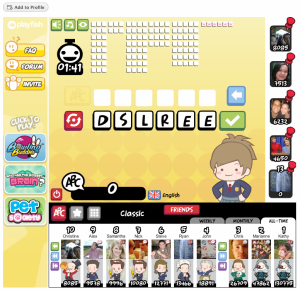
The plan is pretty much what I reported in July, when word surfaced that the search giant was testing the ads. Its decision to enter the market with a public beta test is a big deal because it means that the game advertising market is becoming lucrative enough to attract an industry giant.
“It’s a huge stamp of approval for a major company to come in and say they believe in the online games ad market,” said Jameson Hsu, chief executive of Mochi Media, a game ad network operator which is partnering with Google. “It should awaken all of the major media companies.”
[aditude-amp id="flyingcarpet" targeting='{"env":"staging","page_type":"article","post_id":98781,"post_type":"story","post_chan":"none","tags":null,"ai":false,"category":"none","all_categories":"games,social,","session":"D"}']Google is initially targeting the sweet spot for its technology: games based in Adobe’s Flash platform and which run in a web browser with no download. These are free casual games that are like snacks compared to the full course meals of hardcore console or disk-based PC games.
The Flash market itself is a fast-growing segment, with roughly 200 million games played each month for a total of billions of minutes. It’s a good way to reach younger people or those who are hard to reach because they don’t watch TV commercials anymore.
AI Weekly
The must-read newsletter for AI and Big Data industry written by Khari Johnson, Kyle Wiggers, and Seth Colaner.
Included with VentureBeat Insider and VentureBeat VIP memberships.
Oestlien said that Google’s advertisers can use the software to insert ads into games or videos for YouTube, making the ads more versatile. Developers of games can use Flash software development kits to designate the points in a game that make an “ad request.”
“We’ve tried to integrate this in a user-friendly manner,” Oestlien said.
Advertisers participating in the trials so far include eSurance, Sprint, and Sony Pictures. Other partners include Demand Media and Boonty. Partners such as Mochi Media can help Google by supplying highly trafficked games that can receive ads from Google’s network of advertisers. Google’s main advantage in this business is its large ad sales force, which may generate more advertising inventory than any single player can handle. That’s why it’s important for Google’s ads to be able to run on a variety of sites.
Besides Playfish, other game publishers that will incorporate AdSense for Games technology include Zynga, the hot social gaming company, and Konami, one of Japan’s biggest game companies. The latter will publish a line of Flash titles — including “Track and Field,” “Frogger,” and “Dance Dance Revolution” — with the Google in-game ads.
Full told, more than two dozen games will use Google AdSense for Game at the outset. Oestlien said that the games have millions of users and can create several hundred million ad impressions over time on sites such as MySpace or Facebook.
[aditude-amp id="medium1" targeting='{"env":"staging","page_type":"article","post_id":98781,"post_type":"story","post_chan":"none","tags":null,"ai":false,"category":"none","all_categories":"games,social,","session":"D"}']
Sebastien de Halleux, chief operating officer at Playfish, said that Google’s technology is a good match for his company’s social games and that the pilot went well. Google takes a cut from the ads and the rest goes to the game publishers, distributors or developers.
Oestlien declined to say whether Google would expand beyond the Flash casual gaming segment. But Google’s entry into Flash web games is likely just the first step. After this, you can expect to see the company move into PC downloadable games, console games, and then mobile games. Rivals in those markets include NeoEdge Networks, Microsoft’s Massive, Double Fusion, IGA Worldwide.
This is one more ad market where Google and Microsoft can duel. But all of the competitors had better watch out. Google’s technology is based on a foundation from Adscape, which Google bought for $23 million in 2007. Oestlien said it took time to make that technology compatible with the rest of Google’s ad technology, dubbed AdSense.
The Yankee Group predicts the market will be worth $971.3 million by 2011. Proponents of in-game ads believe that gamers will embrace them because the ads can be integrated into storylines or environments. You can, for instance, put an ad into a billboard inside a game. That ad can change every time the user passes by the billboard. Of course, it’s hard to do that in genres such as fantasy games.
[aditude-amp id="medium2" targeting='{"env":"staging","page_type":"article","post_id":98781,"post_type":"story","post_chan":"none","tags":null,"ai":false,"category":"none","all_categories":"games,social,","session":"D"}']
Google is a bit of a slow mover in this market. In buying Adscape, Google reacted to Microsoft’s own move into in-game advertising. In May 2006, Microsoft bought Massive, the pioneer of in-game ad networks that was founded in 2004. Since the acquisition, the market gathered steam. Alison Lange Engel, global marketing director for Massive, said this summer that the company had more than 200 advertisers in its network and there were dozens of games using Massive’s technology.
The company launched Lively by Google, its 3D rooms and avatars, earlier this summer. Lively by Google would be a natural vehicle for the AdSense for Games product, which could insert ads into the rooms of users, but Oestlien said there’s no connection yet.
VentureBeat's mission is to be a digital town square for technical decision-makers to gain knowledge about transformative enterprise technology and transact. Learn More
